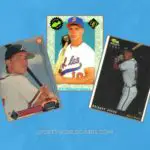If you’re just getting into the world of hockey card collecting, then it might be partly motivated by recent news stories featuring big money sales.
Who doesn’t hear about a Wayne Gretzky “O-Pee-Chee” 1979 rookie card selling for over a million dollars and want to be a part of it? And while most of us will never have cards that valuable, it’s still a fun hobby with a potential for profit.

But if you want to get into hockey sports card collecting, then there’s a lot you need to learn.
There are thousands of hockey cards on the market, and while some rarities are worth staggering amounts, most won’t sell for cents at a yard sale. For new collectors, it can be pretty intimidating.
The first thing you’ll need is an idea of what kind of collector you want to become.
Do you want a big collection with your favorite players, or are you hoping some savvy trades can make you money? No matter which, take a look at this guide to learn what to look for in a hockey card.
What Brands Make Hockey Cards?
Upper Deck has held exclusive rights to the NHL since 2014, and they release a variety of sets each year.
O-Pee-Chee is a vintage-styled set by Upper Deck. Some of the most valuable hockey cards are from O-Pee-Chee (see the Wayne Gretzky rookie card), but these are from older releases, before the company was owned by Topps, and now Upper Deck.
Still, modern cards can be valuable, and many collectors prefer the retro designs of O-Pee-Chee.
Upper Deck also does an MVP series, which includes some fantastic memorabilia and autograph cards.
Upper Deck Series One and Two are the brand’s early and mid-season releases.
The rookie cards are popular in these sets and often considered to be a good future investment (provided you get the right player).
What Should I Look For In A Hockey Card?
Condition
If you’re looking to buy older and vintage cards, one of your first considerations should be condition. As mentioned above, O-Pee-Chee cards are very collectible, and some of them are extremely rare.
But if they’re in poor condition, the value drops significantly. Scuffed edges, creases, fading, lack of gloss, and stains can all affect the value of a card.
Sports cards are graded on a PSA scale — Professional Sports Authenticators. The scale is between 1 and 10, with 10 being the best.
A 10 card is in mint condition and looks fresh from the pack. A 1 is likely to be so badly damaged that the image is unclear. The difference in price between a PSA 10 and a PSA 5 can be hundreds of thousands of dollars.
If you’re buying from new, then it’s down to you to keep your cards in good condition. Otherwise, they won’t retain their value.
Rarity
While condition is important, rarity is even more so. This is where you’ll see the biggest differences in prices.
A lower quality rare card will sell for more than a PSA 10 of a common card. Rarity is determined by how many were originally released, and how many are still on the market.
Rare cards are often older cards, typically from before the 1980s when there was a boom in trading card popularity.
Cards from the 50s, 60s, and 70s, which were produced in low numbers and feature future legends of the sport, are among the most collectible.
But age isn’t everything. Rare cards can be those released on a limited run, autograph cards, rookie cards, and other unique cards.
Produced in low numbers, these would have been desirable even at the time of release. In the ensuing years, some of these cards will have gone missing, or sustained damage. Which means even fewer of them will be around for sale.
Who’s Featured?
There are three reasons why the O-Pee-Chee Wayne Gretzky card sold for so much. First, it was in excellent condition.
Second, it was a rare rookie card with very limited numbers produced. Third, it featured Wayne Gretzky, an absolute hockey legend. Who exactly is featured on the card is a vital factor in sports memorabilia collecting.
The subject is one of the most important things to look for in a hockey card.
There are three ways to go about this: the up and comers, the established vets, and the retired GOATs.
Rookies are popular with collectors, as they’re produced in low numbers, and can increase in value if the player’s career takes off.
Established vets tend to be high in number and low in value, but it’s worth looking for rare printings. And the GOATs can be expensive to invest in, but will likely grow in value.
Is It Real?
So, you’ve located an early Gordie Howe. The condition is impressive, and the printing run is limited. But before you get too excited, there’s one last thing you have to check: is it real?
A fake card can be easy to spot. They won’t have the embossing and quality of image of a real card.
Another key thing to look for is spelling mistakes. For some reason, card counterfeiters regularly forget to run the text through spell check.
But some fakes are carefully and cleverly made and can fool even serious card collectors. Check online resources if you suspect a card is fake.
Final Thoughts
Hockey cards are growing in popularity, and for new collectors, navigating the marketplace can be tricky. Remember the three key points of any valuable card: condition, rarity, and subject.
Keep this in mind when buying new cards as well. Rookies are often a good bet for investors, and limited releases of popular players will often go up in value.
So, make sure to keep your cards safely stored, and avoid excess handling.
Most card collectors will never be lucky enough to come across a 1979 Wayne Gretzky, or a 1966 Bobby Orr.
But that doesn’t mean hockey card trading can’t be a lucrative hobby. And who knows what rookie card you dismiss today might be worth thousands in a few decades.
- 7 Classic John Smoltz Rookie Baseball Cards - October 17, 2022
- Best Josh Allen Rookie Cards - October 12, 2022
- Charles Barkley Cards – Top Picks - August 29, 2022








